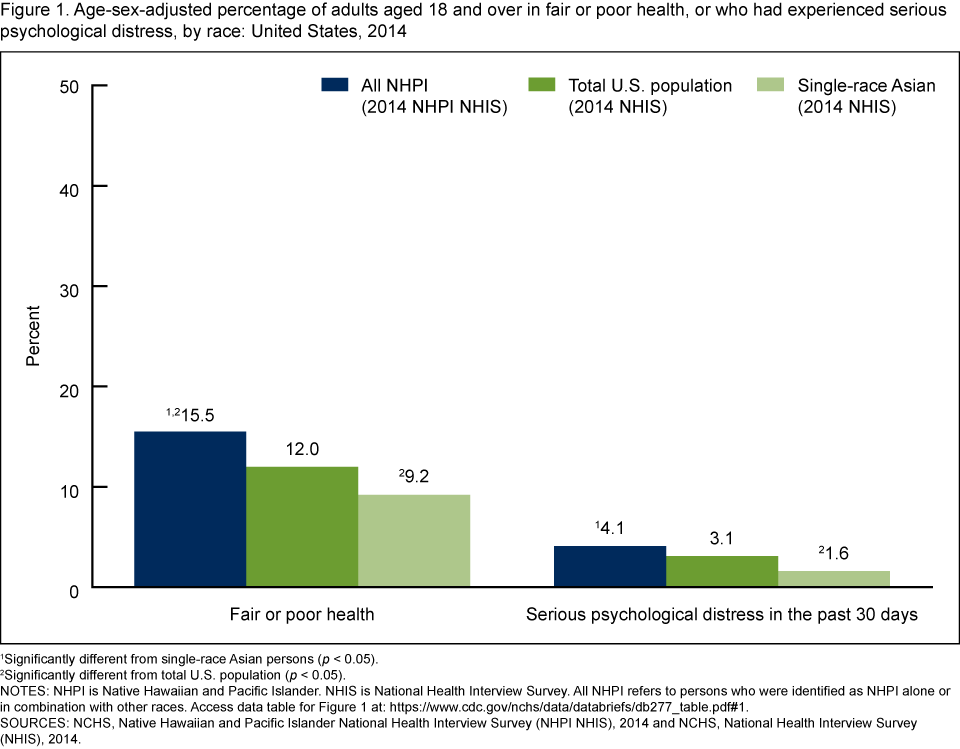Selected Health Conditions Among Native Hawaiian and Pacific Islander Adults: United States, 2014
Posted on byQuestions for Adena M. Galinsky, Statistician and Lead Author on “Selected Health Conditions Among Native Hawaiian and Pacific Islander Adults: United States, 2014”
Q: What factors led you to undertake this analysis on Native Hawaiian/Pacific Islanders?
AG: NHPI became a race group separate from Asians nearly 20 years ago, but there are still few reliable national NHPI health statistics, because the population is numerically small and hard to include in sufficient numbers in national health surveys.
While NCHS as an agency is committed to collecting and reporting health information about all Americans, our goal with this new survey is to fill the gaps in the country’s knowledge about the health of Native Hawaiian and Pacific Islanders in the United States so that others can make decisions based on accurate, reliable, up to date information.
This research is just the beginning of the exciting work that will be coming out using this data.
Q: What do you feel was the most interesting finding in the study?
AG: The pattern of results was the most interesting finding: that for a whole range of outcomes, from serious psychological distress, to arthritis, to asthma, the NHPI population had a higher prevalence than the Asian population.
Q: Is there any comparable data at the moment? Have there been any other studies done on this population and if so, what conclusions were drawn from those studies?
AG: The annual National Health Interview Survey (NHIS) has been publishing NHPI statistics for a while now (since 2003, when data from the 1999 NHIS were published), but because of small sample sizes many of the statistics were unreliable, and not useful for comparing to other populations’ statistics, such as Asian. A few NHPI statistics have been reliable over the years, such as the high prevalence of diabetes in the NHPI population. But trend data has been hard to come by, because even when an NHPI statistic for a given health condition is reliable one year, it’s generally unreliable or suppressed the next.
Q: So the bottom line here is that NHPIs are in poorer health than the U.S. population as a whole?
AG: That’s suggested here but it’s not really the bottom line. The bottom line here is that the NHPI population differs in many ways from the Asian population, and any analysis that presents combined API statistics will likely only tell the story of the Asian population, since that population is so much larger.
Also, it’s crucial that more work is done using the data file that was just released today. This data source is unprecedented and will allow a much more thorough understanding of the health of the NHPI population. We plan to do more research and we are hopeful that many researchers will do the same.
Q: Why would this population lag behind the rest of the population in certain health indicators?
AG: The data in this report do not address that. Other research has shown that there are socioeconomic differences between the NHPI population and the rest of the population. But our report does not answer this question.
Q: Why is it important to compare this group to single-race Asian adults?
AG: The NHPI population has traditionally been subsumed into the “Asian and Pacific Islander” category. The Asian population is much larger than the NHPI population and the question has been whether API statistics were really telling the story of both the Asian and NHPI population, or just the Asian population.
Of course, even within the Asian population there is variation/heterogeneity, but these results, which show the pattern of differences between the NHPI and Asian populations illustrate the danger of assuming that statistics that describe the Asian population also describe the NHPI population.
Posted on by


